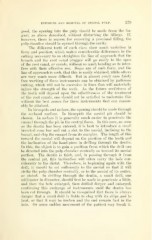Page 733 - My FlipBook
P. 733
EXPOSURE AND REMOVAL OF DENTAL PULP. 379
good, the opening into the pulp should be made from the lin-
gual, as above described, without disturbing the fillings. If,
however, there is reason for removing a proximal filling, the
pulp chamber should be opened through the cavity.
The different teeth of each class show much variation in
form and position, which makes considerable differences in the
cutting necessary to so straighten the line of approach that the
broach and the root canal plugger will go easily to the apex
of the root canal, or canals, without so much bending as to inter-
fere with their effective use. Some are of such form, and the
line of approach is such, that this is easily obtained, while others
are very much more difficult. But in almost every case fairly
free working of these instruments can be obtained by judicious
cuttiug, which will not be excessive in lines that will materially
injure the strength of the teeth. As the future usefulness of
the teeth will depend upon the effectiveness of the treatment
of the root canals, one should not be satisfied to undertake this
without the best access for these instruments that can reason-
ably be attained.
In bicuspids and molars, the opening should be made through
the occlusal surface. In bicuspids the mesial pit should be
chosen. In molars it is generally much easier to penetrate the
enamel through the pit in the central fossa. In this case, as soon
as the dentin has been entered, it is best to introduce a small
inverted cone bur and cut a slot to the mesial, inclining to the
buccal, and chip the enamel from its margins. The length of this
toward the mesial will depend on the position of the tooth and
the inclination of the hand-piece in drilling through the dentin.
In this, the object is to gain a position from which the drill can
be directed into the pulp chamber centrally or toward its mesial
portion. The dentin is thick, and, in passing through it from
the central pit, this inclination will often carry the hole con-
siderably to the distal. Therefore, in beginning again with the
drill, it should be set sufficiently to the mesial so that it will
strike the pulp chamber centrally, or to the mesial of its center,
as stated. In drilling through the dentin, a small drill, one
millimeter in diameter, should first be made to penetrate a little,
and then the hole enlarged, then drilled deeper and enlarged,
continuing this exchange of instruments until the dentin has
been cut through. It should be recognized that there is always
danger that a small drill is liable to clog with its chips and to
heat, or that it may be broken and the end remain fast in the
hole. Or some sudden movement of the patient may break it.


